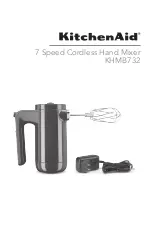
FRONT PANEL DESCRIPTION
1. MIC / LINE SELECT SWITCH.
A pushbutton switch which in its
out
position
determines that the 3-pin MIC INPUT on the rear will be active and structures the input
gain accordingly. In the
in
position the balanced ¼" LINE INPUT is active and gain is
reduced to suit.
2. 48V PHANTOM POWER SWITCH.
In the “on” position, 48 volts D.C. phantom
power is applied to pins 2 and 3 of the 3-pin MIC INPUT connector.
3. INPUT GAIN CONTROL.
This rotary control increases input GAIN as it is rotated
clockwise. Its range is from 20dB at full CCW rotation to 60dB at full CW rotation.
4. 20dB PAD SWITCH.
In its 20dB postion, this switch decreases the gain range of
the input GAIN control (item #3, above). by 20dB, which is times ten. If it is set to its
NORM position, the calibrations indicated above are true.
5. CHANNEL OVERLOAD INDICATOR.
This red LED illuminates any time any
signal level is within 4dB of clipping. Five key locations are monitored.
6. HIGH FREQUENCY EQ CONTROL.
This rotary control determines the amount
of boost or cut applied to the FMI 14’s passband by its Accelerated Slope™ high frequency
filter. The center detent, cleverly placed at the center of rotation of this control, provides a
ground for the filter which bypasses it. Rotating this knob clockwise increases the gain of
the of the mixer above 7kHz in a shelving fashion to a maximum of +12dB; CCW from
center decreases the gain to a minimum of -15dB.
7. MIDRANGE EQ CONTROL.
As above, clockwise rotation increases gain, how-
ever in this instance we have a bandpass type curve as opposed to a shelving characteristic.
Again, the range is from -15dB to +12dB.
8. MIDRANGE BANDWIDTH SELECTOR.
This three-position switch allows the
user to select 1/3, 1 or 2 octave coverage from the midrange filter.
9. MIDRANGE CENTER FREQUENCY CONTROL.
A rotary control which
determines the center frequency of the midrange filter. Its range is from 95Hz to 4kHz.
10. LOW FREQUENCY EQ CONTROL.
This rotary control determines the amount
of boost or cut applied to the FMI 14’s passband by its Accelerated Slope
™
low frequency
filter. The center detent provides a ground for the filter which bypasses it. Rotating this
knob clockwise increases the gain of the mixer below 100Hz to a maximum of +12dB in a shelving fashion; CCW from
center decreases the gain to a minimum of -15dB.
11. EQUALIZER DEFEAT SWITCH.
In its
out
position, all audio is routed around the equalizer section defeating its
action. Only when it is pressed
in
will any of the equalizer controls be active.
12. AUX SEND SELECTOR SWITCHES.
These switches determine the source for the Auxiliary Outputs, A and B. In
the PST FD position, the respective Aux Out is picked up after the Master level controls. In the PRE FD position, the source
is after the EQ, if engaged, but prior to the Master levels. If PRE EQ is used, the signal is obtained before the EQ section.
13. AUX A / B SEND CONTROLS.
These rotary controls determine the output level to both the direct ¼" AUX OUT-
PUTS on the rear as well as the Aux sends in the BUS OUT connector.
14. MASTER A / B LEVEL CONTROLS.
These concentric rotary controls determine the output level to both the direct
¼" MASTER OUTPUTS on the rear as well as the Master outputs in the BUS OUT connector. Rotated together, they act as
a conventional level control. Rotated individually, they create a pan function.
15. POWER INDICATOR LED.
This yellow LED illuminates any time an approved Rane AC remote power supply
such as an RS 1 (included), RAP 10, VC 18 or an FRS 8 is connected to the unit and is active.






















